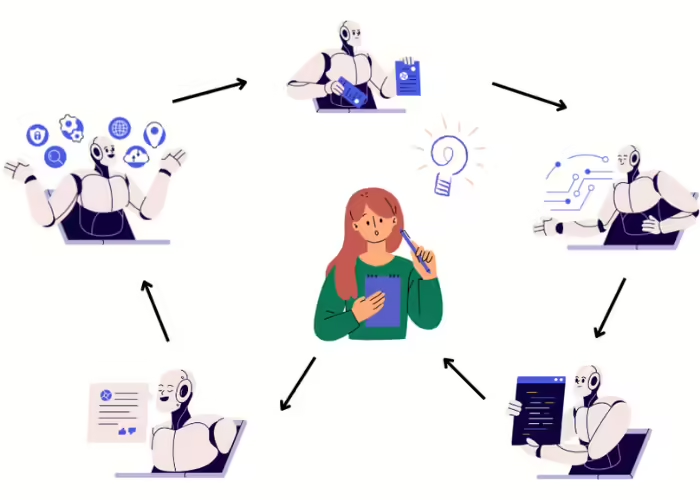
In today’s fast-moving digital landscape, time is perhaps the most valuable resource. Whether you’re a business owner, a marketer, or a content creator, finding ways to boost efficiency is essential. That’s where artificial intelligence (AI) comes into play. Using AI to automate content creation—whether for blogs, newsletters, or email campaigns—comes with a wide range of perks, from boosting productivity to ensuring your content hits the mark. It’s not just the latest trend; it’s a strategic move that allows creators to focus on what truly matters—the human element—while letting tech handle the repetitive stuff. This article explores just how AI is transforming the way we create and share content.
AI and Its Role in Modern Marketing
Artificial intelligence has already shaken up plenty of industries, and marketing is no exception. The way AI can mimic human intelligence means it can take on tasks like writing, analyzing data, and predicting trends—all key in the world of marketing.
Look at social media, for example. AI is the driving force behind what content you see, moderating conversations, and even suggesting new accounts to follow. The same tech can take a lot of the legwork out of creating content like blogs, newsletters, and emails. It doesn’t just save you time; AI tools provide useful insights and recommendations to make your marketing efforts more effective overall.
Benefits of Utilizing AI for Automating Blogs
Blogs are vital for driving traffic, building authority, and connecting with your audience. But cranking out high-quality, SEO-friendly content on a consistent basis? That can be a grind. Here’s where AI can step in and lighten the load.
1. Automating Topic Research and Keyword Selection
- AI can analyze vast amounts of data to identify trending topics and relevant keywords. It allows content creators to pinpoint exactly what their audience is interested in at any given time. For example, AI tools can assess data from social media, search engines, and other online platforms to predict which topics will resonate most. This eliminates the guesswork from topic selection and ensures blogs are always relevant and timely.
2. Enhanced SEO and Content Optimization
- SEO is crucial for any blog, and AI-powered tools can optimize content in ways humans might overlook. From keyword density to meta descriptions, AI algorithms can suggest changes that boost the blog’s search engine ranking. Additionally, AI can optimize the readability of content, ensuring it appeals to a broader audience and aligns with search engine requirements.
3. Creating First Drafts and Enhancing Writing
- Generative AI tools can produce first drafts of blog posts, saving writers hours of time. These tools can generate content based on prompts, delivering structured, coherent articles that writers can then refine with their own unique voice and perspective. This method speeds up the writing process while maintaining the personal touch necessary for engaging readers.
4. Analyzing Performance and Suggesting Improvements
- AI doesn’t stop at content creation. It also plays a role in performance analysis. By tracking engagement metrics such as views, shares, and time spent on a page, AI tools can suggest content improvements. For instance, they can identify underperforming posts and recommend updates to headlines or content structure to drive better results.
AI in Newsletter Automation
Newsletters are an incredible way to maintain a strong connection with your audience. But crafting personalized, engaging content for each subscriber? That’s a lot of work. Luckily, AI can make the whole process smoother.
1. Personalization at Scale
- AI excels in personalizing content for individual readers. It can analyze subscriber data, such as past interactions or preferences, and tailor newsletter content accordingly. This ensures that every subscriber receives content that is relevant to them, which significantly increases open rates and engagement.
2. Automated Content Curation
- Curating content for newsletters can take hours. However you can automatically pull in content based on specific topics, keywords, or user interests. This automation reduces the workload on content teams and ensures newsletters are always filled with relevant, high-quality material.
3. A/B Testing for Optimized Content
- AI can assist in A/B testing by automatically running multiple versions of a newsletter and analyzing which version performs best. It can recommend changes to subject lines, calls-to-action (CTAs), and even layout designs based on real-time feedback, ensuring your newsletters are always optimized for performance.
4. Scheduling and Automation
- The timing of a newsletter can be critical to its success. Analyze subscriber behavior and suggest the optimal times to send emails. Whether your audience engages more during the early morning or late at night, AI can handle scheduling to maximize open rates and engagement.
Enhancing Email Campaigns
Email marketing remains one of the most effective tools in the marketing toolbox. But managing all those campaigns manually can feel overwhelming. AI can take on the heavy lifting, leaving you free to focus on strategy.
1. Dynamic Content Creation
- AI can generate personalized email content based on user data. For example, AI tools can craft customized subject lines, body text, and CTAs tailored to individual recipient preferences. This ensures that emails speak directly to the recipient, increasing the likelihood of engagement and conversions.
2. Predictive Analytics for Targeting
- Predictive analytics, powered by AI, can predict which users are most likely to take action after receiving an email. By analyzing past behaviors, such as previous purchases or interaction with content, AI can help segment audiences and send targeted emails to those most likely to convert.
3. Optimizing Delivery Time
- Much like with newsletters, AI can determine the best time to send emails for maximum engagement. This is especially important when dealing with large, segmented audiences. Instead of sending emails in bulk, AI can ensure that each recipient gets the email at a time when they’re most likely to engage with it.
4. Automating Follow-ups and Drip Campaigns
- AI can automate follow-up emails and drip campaigns based on recipient behavior. If someone opens an email but doesn’t click the CTA, AI can trigger a follow-up email with new messaging designed to drive action. Similarly, for leads who engage with multiple emails, AI can manage the flow of a drip campaign, gradually nurturing them toward conversion.
The Impact of AI on Productivity and Costs
AI’s ability to automate blogs, newsletters, and emails doesn’t just save you time—it can also help reduce costs. By taking over tasks that used to require hours of manual effort, AI allows you to scale up content creation without having to hire more staff. And because AI continuously learns and improves, your content quality gets better the more you use it.
Conclusion: Why You Should Embrace AI for Content Automation
Leveraging AI for automating blogs, newsletters, and email campaigns is not just a tech trend—it’s a smart, future-forward strategy. By embracing AI, you can streamline time-consuming tasks, gain actionable insights, and optimize your content for better results—all while saving valuable time and resources. Whether you’re running a small business or leading a large marketing team, AI gives you the tools to scale your efforts, personalize your communication, and stay competitive in today’s fast-paced digital world.





